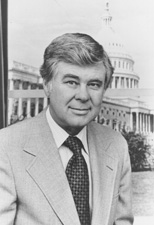 U.S. Senate Chamber in 1873
U.S. Senate Chamber in 1873
His political career continued after that, with a few bumps along the way, and in 1894 he was elected to the U.S. Senate for one term in the state’s second seat and then in 1904 was elected to a term in the state’s first seat.
The best way to think of Montana’s two U.S. Senate seats is to go back to how they started. Both began with the 51st Congress that started in 1889. The first seat was held by Wilbur Fisk Sanders, who only served two of his three congressional terms – the seat was vacant from 1893-5. The second seat was first held by Thomas C. Power, also beginning in 1889.
Montana’s First U.S. Senate Seat
 Joseph M. Dixon, c 1910s
Joseph M. Dixon, c 1910s
Joseph M. Dixon took the seat back for the Republicans in 1907 when Clark chose not to run again, but then Dixon’s decision to switch to the Bull Moose Party in 1912 cost him the election and Republicans the seat. Thomas J. Walsh would come to embody the seat and make it easily-identifiable as Democratic. He served until 1933 and then governor John. E. Erickson appointed himself to finish the term upon Walsh's sudden death.
 James Edward Murray
James Edward Murray
At that point John Walsh was appointed to fill the seat and was running for election outright in 2014 when plagiarism charges ended his campaign and he was forced to drop out. Amanda Curtis, a young 34-year-old school teacher from Butte, was nominated to replace him. As of this writing the race between Curtis and U.S. Representative Steve Daines is close, with two months to go.
Montana’s Senate Seats in History
 Burton K. Wheeler, c 1930s
Burton K. Wheeler, c 1930s
Just looking at the long stretches of time that the seats were held by the two parties is telling as well. From statehood in 1888 to the 1912 elections the two seats were overwhelmingly Republican. During that time there were Republicans in both seats from 1889 to 1899 and again from 1907 to 1911. Democrats were only present in both seats from 1901 to 1905.
 John Melcher
John Melcher
From 1911 to 2014 Montana’s first Senate seat has been held by the Democrats 79 years and the Republicans just 24 years. In comparison, from 1913 to 2014 Montana’s second Senate seat has been held by Democrats without interruption, an astonishing 101 years.
There’s a saying in Montana that people send the liberals and Democrats back East to get rid of them, and that’s one way to explain such a long dominance of the Democrats over Montana’s affairs nationally. Another is to say they do a good job.

